A Bowl Full Of Pasta Engineering
11:15 minutes
When you walk down the pasta aisle at the supermarket, there are so many tasty choices: There’s the humble spaghetti, the tubes of ziti, the tiny shells, and the butterfly-like farfalle. But every pound of pasta is not created equal—some of the boxes pack mostly air.
In recent work published in the journal Science Advances, Dr. Lining Yao of Carnegie Mellon’s Morphing Matter Lab and her colleagues discuss an innovative way to solve the problem of puffed-up pasta boxes: What if different pasta shapes could be flat-packed into containers like DIY IKEA furniture?
The researchers developed a way to map out tiny grooves and ridges on the surface of a flat noodle sheet. When the pasta is cooked in hot water, it swells at different rates around the ridges and grooves, causing it to fold on its own into shapes such as boxes, rose-like flowers, and helix curls. Yao joins SciFri’s Charles Bergquist to talk about the research, and the challenges of making your dinnertime pasta plate into an origami craft project.
View more of these pasta shapes up close and in action! All images courtesy Carnegie Mellon’s Morphing Matter Lab.
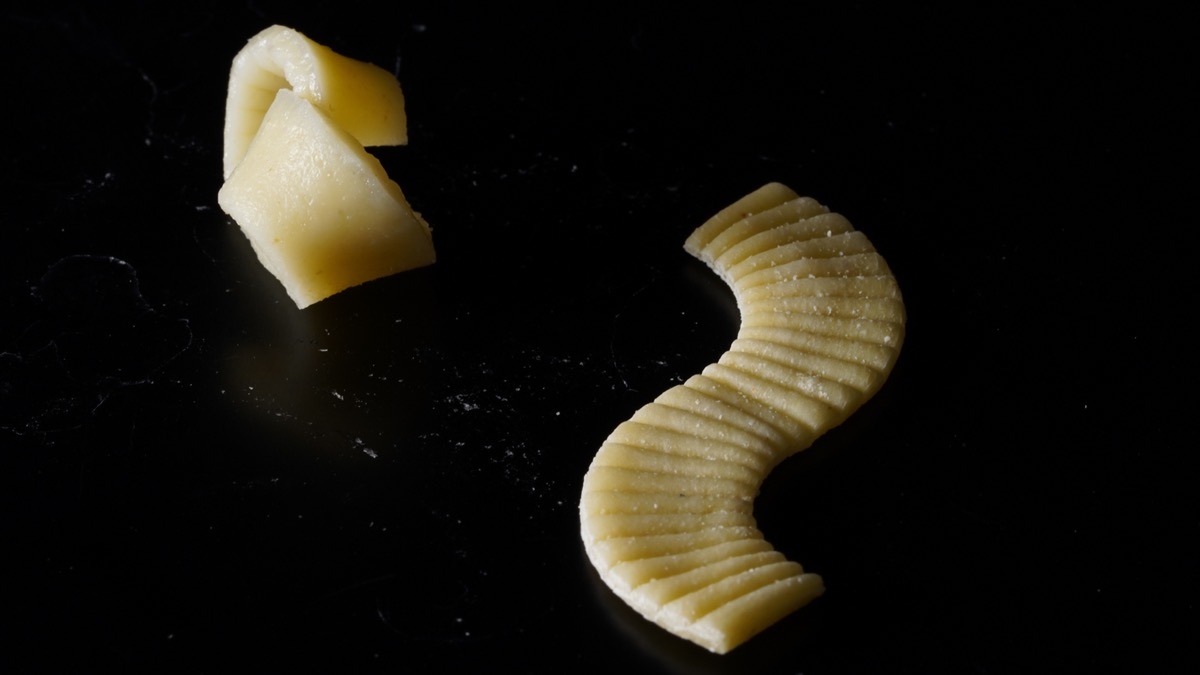
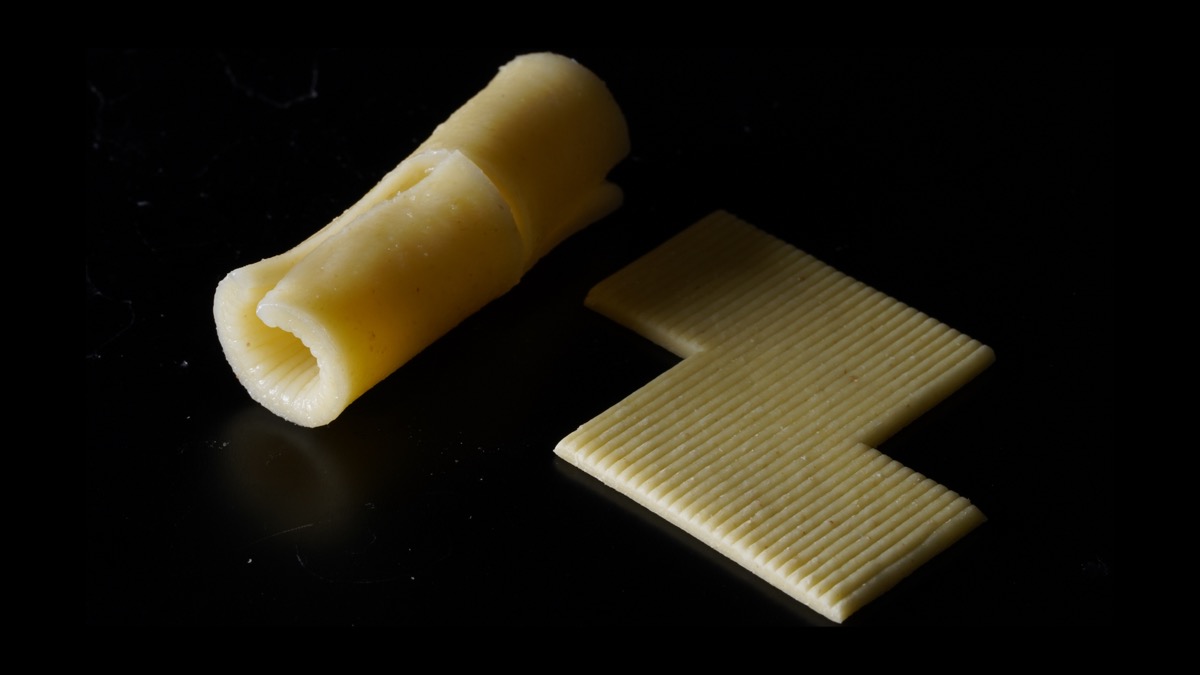
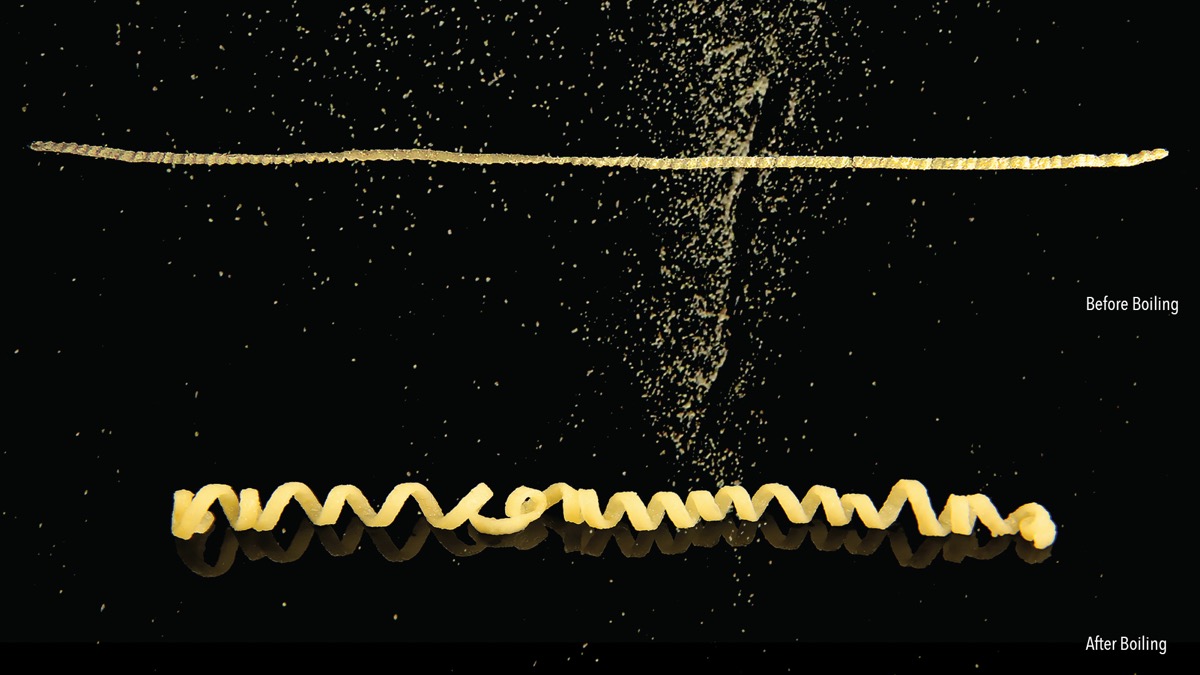
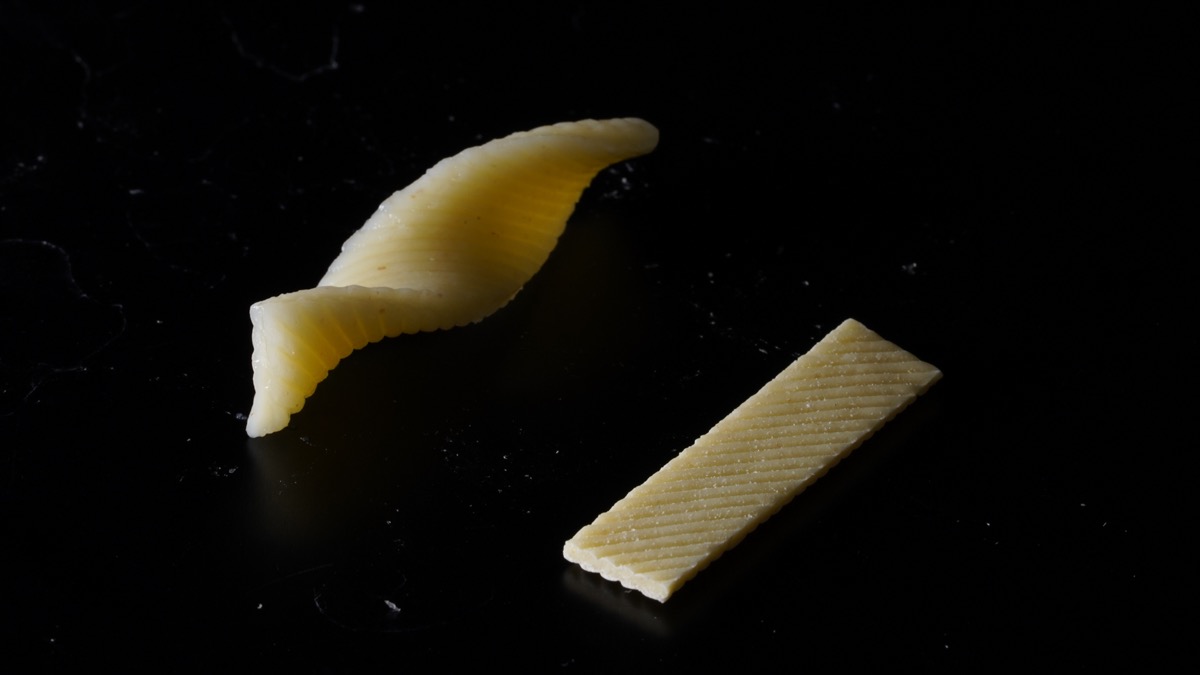
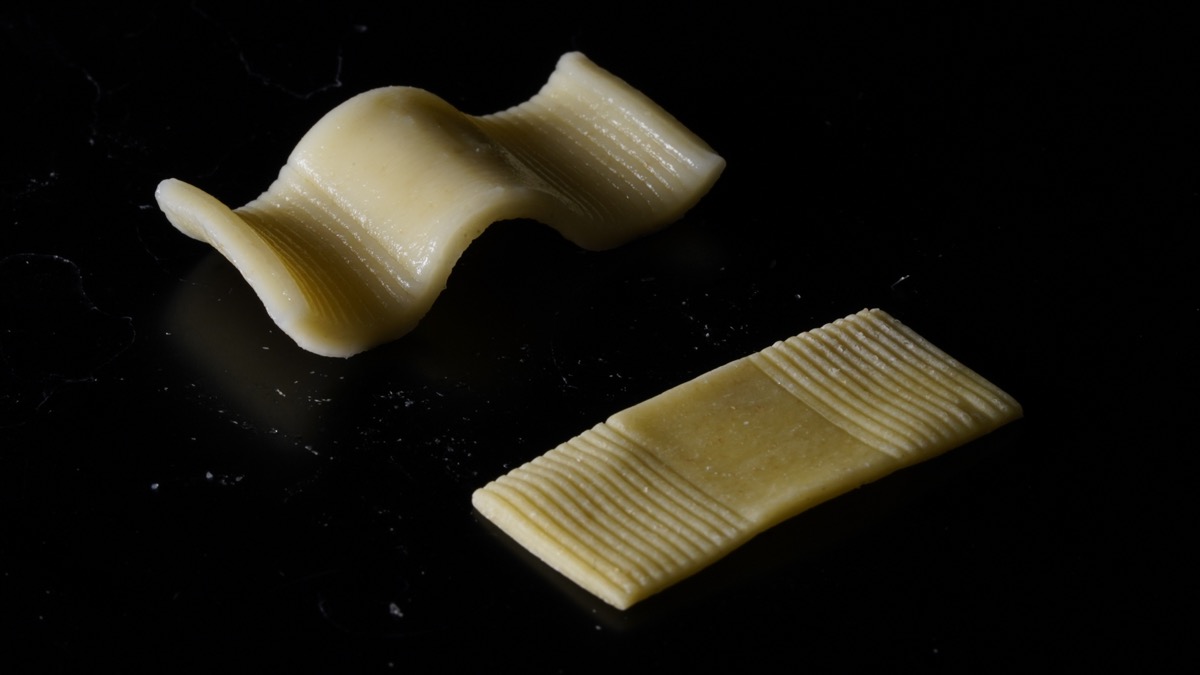
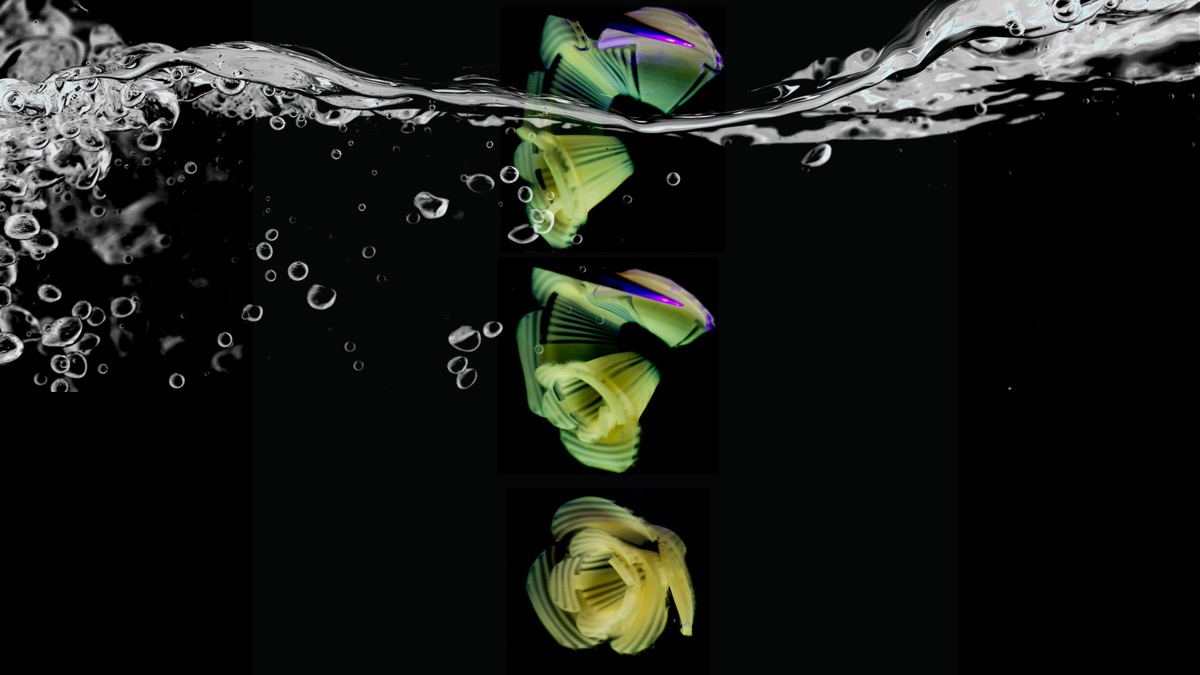
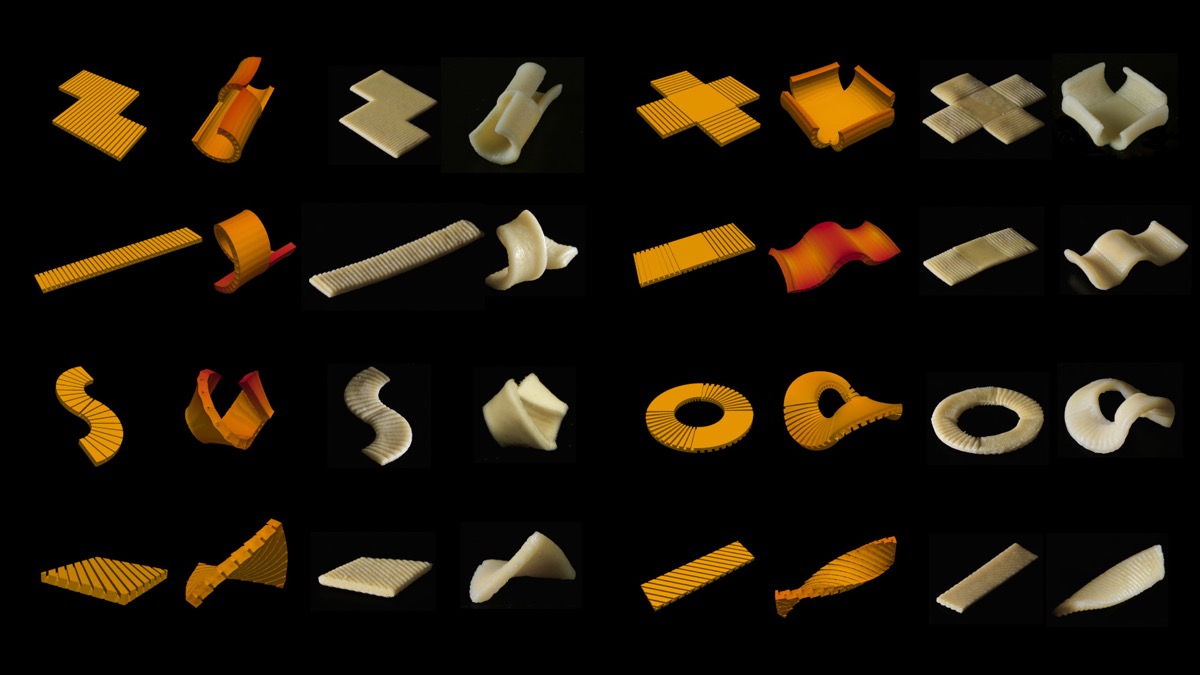
Invest in quality science journalism by making a donation to Science Friday.
Lining Yao is an assistant professor and director of the Morphing Matter Lab in the School of Computer Science at Carnegie Mellon University in Pittsburgh, Pennsylvania.
JOHN DANKOSKY: This is Science Friday. I’m John Dankosky. When I walk down the pasta aisle at the grocery store, I am amazed by all the different shapes and sizes. There are those big shells, the twisty rotini, the tubes of ziti, the farfalle butterflies– or maybe they’re bowties– and of course, the flat linguine noodles. Each one for a different recipe, or maybe a different sauce pairing.
But what if your pasta could change shape? Here’s SciFri’s Charles Bergquist. Hi, Charles.
CHARLES BERGQUIST: Hey, John.
JOHN DANKOSKY: So I love big noodles, the ones that are kind of shaped like calamari rings. But what’s this about them changing shape?
CHARLES BERGQUIST: Researchers are investigating how to get a flat sheet of pasta to fold itself up into tiny boxes or rose flower shapes or spirals when you cook it.
JOHN DANKOSKY: Oh, that sounds cool. So more than just going from dried pasta to an al dente noodle.
CHARLES BERGQUIST: Yeah, this is pasta that folds itself up like origami. And I asked Dr. Lining Yao of Carnegie Mellon’s Morphing Matter Lab about just why they were working on this problem.
LINING YAO: So we were very inspired by the idea of flat-pack from the furniture industry. And we’d read news articles about how furniture is saving millions, if not billions, of dollars every year globally by just flat pack, but also, that’s just good for the environment. When we can’t cut consumption, at least we can cut a lot of shipping space and the packaging cost and space.
Similarly, we also learned food packaging is one of the big waste sources. And we thought, hey, why don’t we borrow this flat-pack idea and combine that with a morphing technique we’ve been developing and try to think about morphing food? Then, if you talk about food, pasta is one of the big players, because it’s a commodity type of food.
And we are also interested in starting with pasta because there are very rich shapes in pasta. Macaroni, for example– they pair with different sauce with different surface textures and flavor than spaghetti. But macaroni, comparing to spaghetti, has more than 60% of the packaging space that is used for packing air. And we thought it would be great if we pack all the pasta flat to save more than half of the packaging space you need, but then you can still get to eat in shape you want. It’s also just kind of magical. Magic empowered by science– that’s the part, as researchers, we love, yeah, to enable.
CHARLES BERGQUIST: Can you make any shape you want, or are there shapes that are just out of the realm of your capabilities?
LINING YAO: So with a grouping mechanism, you can make quite a lot of different shapes. So in the paper, we showed you can make, for example, quite sophisticated rose flowers. We made shapes like a box, in the common helix, macaroni pasta shaped like a cylinder. We also showed, I believe, some saddle shapes, a little bit like potato chips.
And geometrically, we would define most of the pasta shapes as developable geometry. So as the next step, we are very interested in understanding how to engineer nondevelopable geometry. Putting into simple words, nondevelopable shapes are shapes like a dome or like a cone. So if you want to make a seamless bowl or a dome, that’s actually quite of a challenge.
CHARLES BERGQUIST: So it might be hard to make the all-important little tiny dinosaur-shaped pasta or little spaceships or something like that.
LINING YAO: Spaceship, it depends. So another way to understand what we can do right now is, if you can imagine the shape being possible with origami, with a piece of paper, you can likely do it.
CHARLES BERGQUIST: OK, so I need to be able to take a flat thing and somehow segment it just with corners and ridges, but I can’t pull it. I can’t– can I twist it?
LINING YAO: You can introduce hinges, or folding hinges, at locations you want. And then they pretty much self-morph like how origami will fold. But in our case, they do it by themselves, like autonomous folding. And you can do twists, indeed. We actually showed– like potato chips, if you think about it, it’s a saddle shape that is one twist. But we can also do helical structures.
CHARLES BERGQUIST: Is it hard to out the arrangement of grooves and ridges that you would need to build a specific shape, or is it just as simple as, I want it to fold this way, I put a groove here, and it does it?
LINING YAO: One major intellectual contribution we introduced in the paper is the design guidelines that tell people the rational design behind the shapes we showed. We introduced, basically, two primitives, if you will. One is parallel groups. Basically, if you introduce parallel groups, you basically can introduce a curve, a folded hinge.
And another primitive is radial symmetrical groups. And those will form cones. And then if you combine multiple cones together in different regions and different orientations, you can suddenly make shapes like the rose flower we showed.
And this is only step one. Again, it’s still more of a geometrical primitive way of thinking about things. Right now, our lab is developing a machine learning-powered design tool, and we wanted the tool useful for people who are not interested in understanding these geometry principles, like maybe a chef. We can basically input or call out the shape they want.
So for example, oh, I want a rose flower. And we will be able to convert the 3D shape they want into a flat sheet, and also, with suggested groove patterns. And in those case, you would just basically need to make a stamp, and then directly, yeah, introduce grooves on your pasta.
CHARLES BERGQUIST: So you’re doing origami with the pasta noodles, but walk me through what’s actually happening on a physical level. What’s causing the pasta to fold?
LINING YAO: In the case of pasta, we’re actually looking into differential swelling behavior. Basically, the region that is exposed to water will swell more. For the places that are covered by a grooved wall, let’s say, the water has to take time to penetrate into the center part of the pasta sheet. So the slight different timing in terms of the water reaching the same horizontal line of the pasta sheet really caused the transformation.
CHARLES BERGQUIST: Does it fold towards the groove, away from the groove? How should I be thinking about this?
LINING YAO: So when you think about pasta, the pasta will basically fold towards the grooved side. So the convex region is really blocking the water from penetrating. So that basically causes– the side with a groove averagely will swell more slowly than the side that does not have grooves. So you know, the side that swells more slowly will end up smaller surface area. And then, if you look at this as a complete structure, it will suddenly become a bilayer, and then bend towards the side with the groove.
CHARLES BERGQUIST: So do these rules apply to any material, or is there something special about the flour in the pasta that makes this possible?
LINING YAO: The beauty of this phenomenon is this is a universal morphing mechanism. It’ll work for most, if not all, material that can readily swell in water or in a solvent. So in the case of edible material, we tried different kinds of flours, but you can also imagine food gels– for example, gelatin, agar, seaweed gels. All these gels can possibly morph in a very similar way.
And beyond food, we also showed in our paper you can make– for example, silicone rubber folds and unfolds in a very similar way. But in that case, you will have to use the organic solvent instead of water, because the silicon rubber will swell more readily in organic solvent than in pure water.
CHARLES BERGQUIST: Are there things out in nature that are doing this already that we haven’t noticed?
LINING YAO: Scientists definitely noticed. And there are very interesting phenomenons in nature in terms of morphing triggered by diffusion. So for example, pinecones. Nature made them to be responsive to the moisture level in the environment. And we are very inspired by these similar kind of nature bilayers.
But in their case, the swelling is due to the microscopic structures at the cell level and the arrangements of the cell and fiber contents. It’s less about surface grooves, per se. Swelling mechanism is very similar, but the structure design is slightly different in our case.
CHARLES BERGQUIST: Did your lab have a lot of pasta parties while you were working on this research?
LINING YAO: We had a few. Once, we actually went on a hiking trip. We made a bunch of pasta flat packed in a little paper box. And I also had once a pasta party at my home. We actually ended up cooking three or four different kinds of morphing pasta. I invited my researchers in the lab to try it out. You know, they were chatting, but also giving us some feedback.
CHARLES BERGQUIST: And it tastes like regular pasta? Can I tell if I’m eating it that, oh, this is weird origami pasta?
LINING YAO: For most of the feedback we got, they didn’t really felt this is very different. But like I said, the original recipe is really just made of the same semolina flour and water. They are just differing in shapes. Of course, you will have different texture, feeling. That’s the purpose of why we want to make different shapes.
But yeah, in terms of– we are very proud. The reason we were looking into like a groove and surface texture-based morphing mechanism is that we do not want to modify the conventional pasta recipe, because food is such an industry that’s tied to culture, tradition, right? We want to as much as possible kind of preserve the raw material recipe, which is honestly one of the biggest challenges, because as a material engineer, we do morphing matter. There are some common techniques merely by changing the composition and the chemical structures. But for food, we are kind of constrained, in that sense.
CHARLES BERGQUIST: Dr. Lining Yao is director of the Morphing Matter Lab in Carnegie Mellon’s School of Computer Science in Pittsburgh. Thank you so much for taking time to talk about this with me.
LINING YAO: Yeah, it’s my pleasure. Thank you.
CHARLES BERGQUIST: And you can see some videos of this magic morphing pasta on our website at ScienceFriday.com/pasta. For Science Friday, I’m Charles Bergquist.
Copyright © 2021 Science Friday Initiative. All rights reserved. Science Friday transcripts are produced on a tight deadline by 3Play Media. Fidelity to the original aired/published audio or video file might vary, and text might be updated or amended in the future. For the authoritative record of Science Friday’s programming, please visit the original aired/published recording. For terms of use and more information, visit our policies pages at http://www.sciencefriday.com/about/policies/
As Science Friday’s director and senior producer, Charles Bergquist channels the chaos of a live production studio into something sounding like a radio program. Favorite topics include planetary sciences, chemistry, materials, and shiny things with blinking lights.